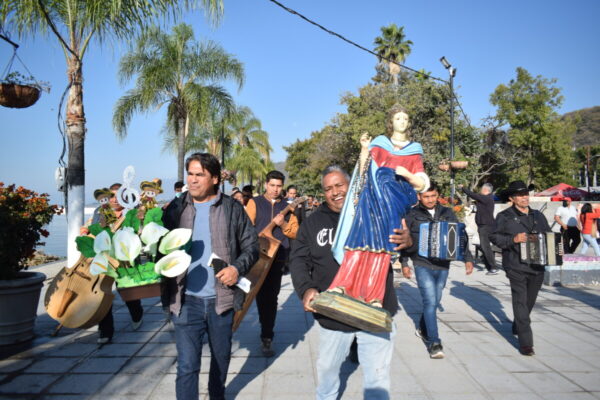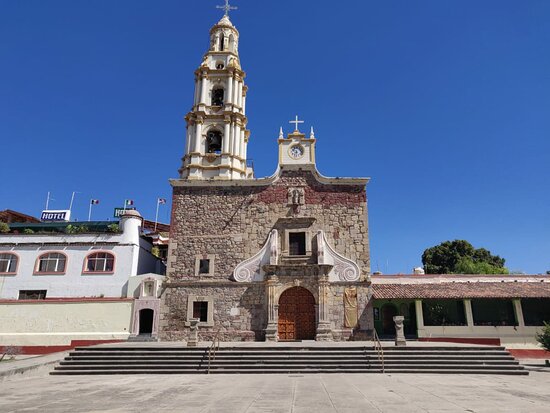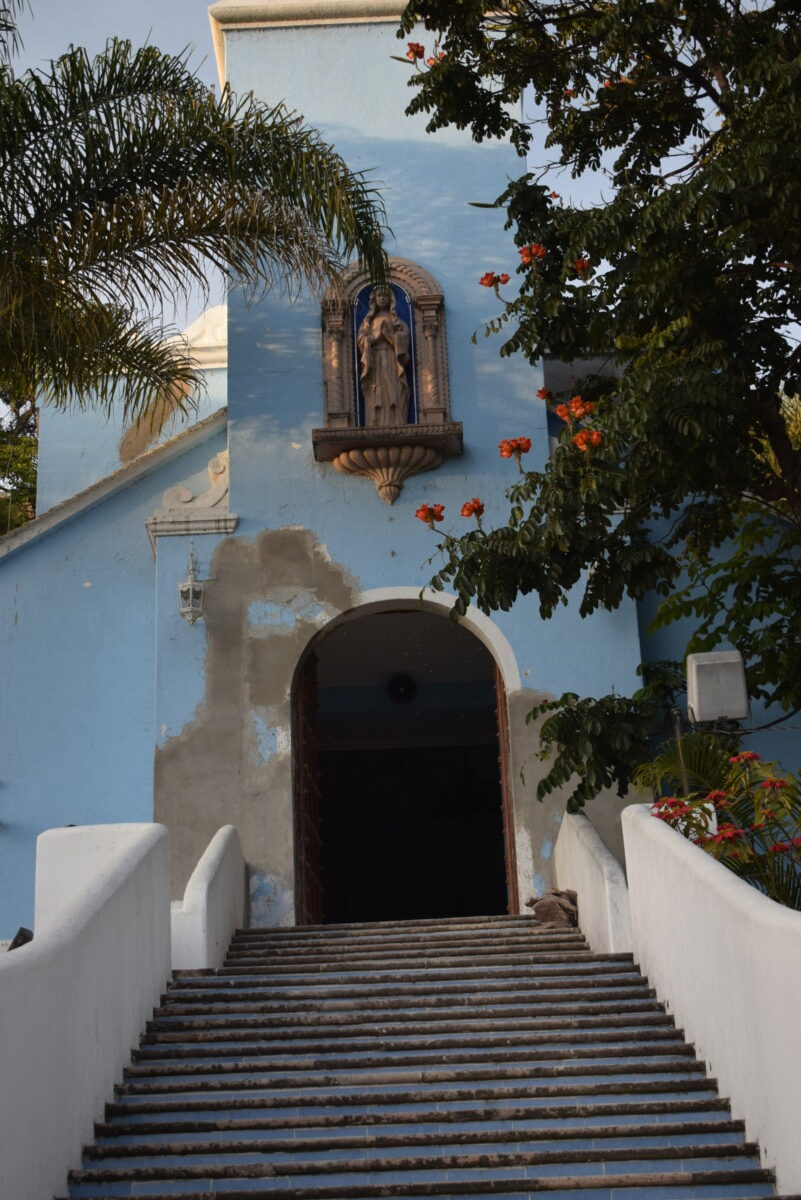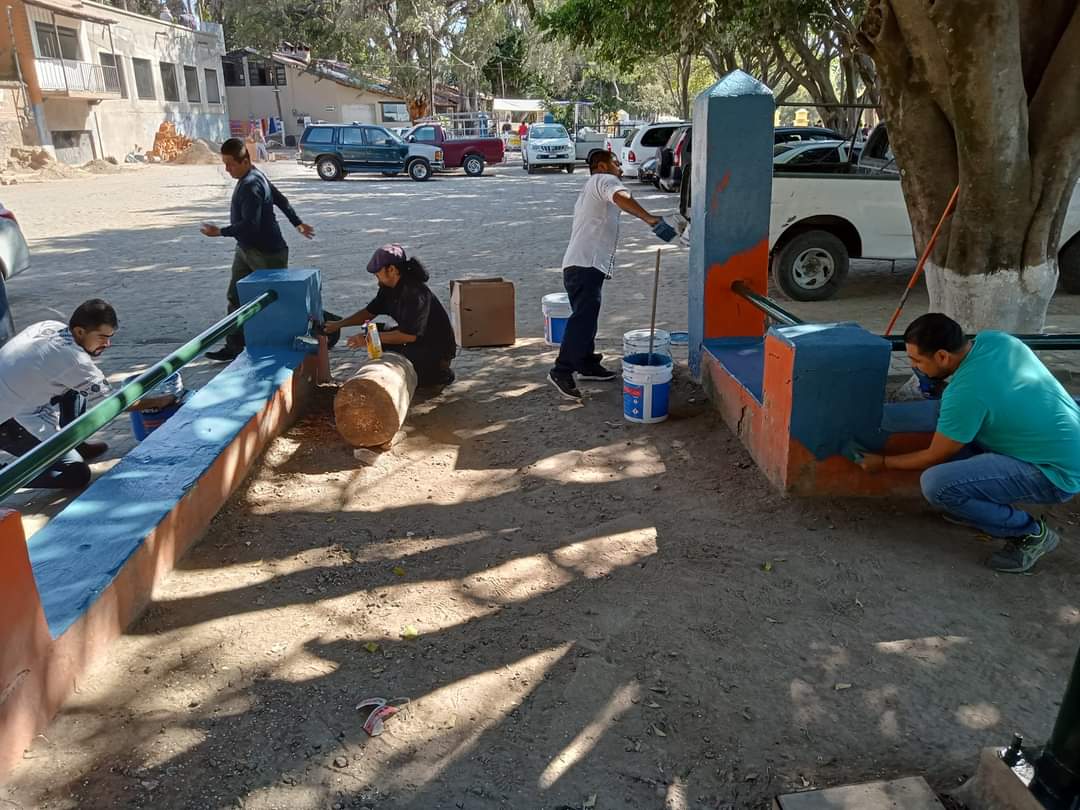Localidades
Talleres culturales de San Antonio Tlayacapan obtienen buena respuesta
Muñecos realizados en el taller del pasado domingo 14 de noviembre. Foto: Cultura Tlayacapan.
Sofía Medeles (Ajijic, Jal.)- Desde el inicio del mes, se han estado realizando talleres culturales en San Antonio Tlayacapan, los cuales han sido bien recibidos por habitantes de la delegación, según palabras del encargado de cultura del pueblo, Octavio Ignacio Pérez.
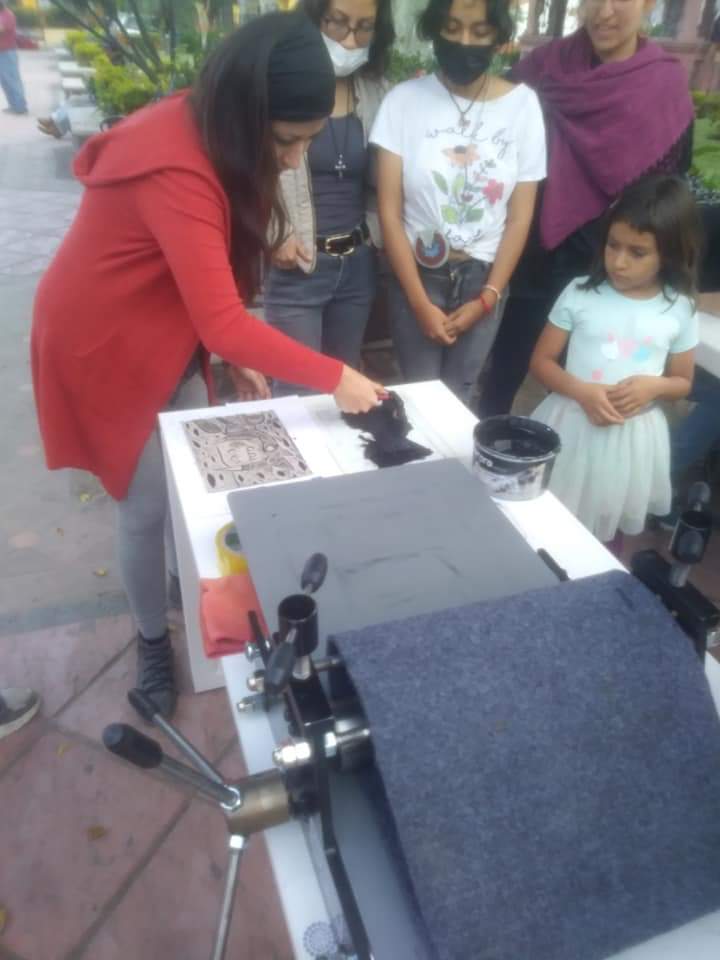
Personas en el taller de grabado en linóleo. Foto: Cultura Tlayacapan.
Hasta el momento, se han realizado cuatro talleres: calaveritas, muñecos mexicanos, introducción a la cartonería y grabado en linóleo; los cuales han llenado su cupo, y se han realizado con ayuda de grupos como EsuWit, Rutas Plásticas A.C., Semilla Gráfica, y el director de cultura de Ajijic, Santiago Baeza.
“La respuesta ha sido buena por varios factores, como puede ser que la mayoría de los talleres son gratis, que la gente ya quiere salir de esta pandemia, etcétera. Y aunque los talleres son para pocas personas por esto mismo, en la medida de lo posible, se buscará abrir más grupos y meter disciplinas como música, danza folclórica, teatro, entre otras”, mencionó Octavio.
Sobre los talleres, aseveró que es una actividad fuerte, una de las maneras de visibilizar la cultura, y son un buen mecanismo para desarrollar distintas actividades; además, de que permiten sensibilizar al poblador al arte. Finalmente, agradeció a autoridades municipales y al presidente Alejandro Aguirre, por sus respectivos apoyos para la realización de los talleres.
Para estar al tanto de talleres, convocatorias y demás, se publican por medio de la página de Facebook Cultura Tlayacapan, donde se dan detalles de cada curso.
Se arrestan a 19 personas por delitos contra la salud y robo en Chapala
Foto: Patrulla de la SSE. Foto: cortesía.
Redacción (Chapala, Jal).- Diez y nueve personas fueron arrestadas entre el 1 de octubre y el 22 de noviembre de este año, por delitos contra la salud y robo en Chapala.
Las acciones permitieron el arresto de 18 personas en presunta posesión de drogas y un detenido con un vehículo robado. Asimismo, dos personas fueron arrestadas por incurrir en faltas administrativas.
En dicho periodo, fueron recuperados 12 vehículos y una motocicleta con reporte de robo, así como una motocicleta que fue abandonada con droga.
La SSE tuvo un acercamiento con vecinos de Chapala para escuchar sus demandas en cuanto al mejoramiento de la seguridad en la ribera, por lo cual se puso en marcha una estrategia para cumplir con este objetivo.
Además, para evitar la delincuencia situacional, el personal de la Dirección de Prevención del Delito de la SSE realizó una proximidad con los ciudadanos de este municipio, difundiendo las medidas preventivas en cuanto al robo a persona, robo a negocio y robo a casa habitación, entre otros delitos.
Tradición, fe y alegría dan vida al Día del Músico en Chapala
Luego de una misa celebrada en la Parroquia de San Francisco de Asís, los músicos llevan en un recorrido a la imagen de Santa Cecilia por el malecón de Chapala. Foto: Jazmín Stengel.
D. Arturo Ortega. – Con fe, tradición y música se vivió el 22 de noviembre, Día del Músico en Chapala, lugar donde desde muy temprano, por la mañana grupos de norteño, mariachis, tríos y solistas que laboran en los lugares más visitados de la cabecera municipal, se dieron cita en la Parroquia de San Francisco de Asís y el extremo oriente del malecón para celebrar a la patrona, Santa Cecilia.
A través de una serie de imágenes tomadas por Jazmín Stengel, te compartimos cómo la fe y la devoción se manifestó durante este día tan significativo para el gremio de la música:

Una vez en la zona restaurantera, los músicos interpretaban canciones a petición de los lugareños de cada restaurante.

Los años de experiencia de algunos músicos son notables cuando interpretan las canciones de su repertorio.
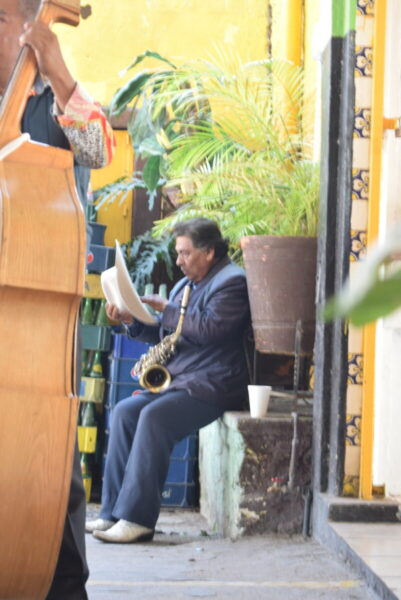
Luego de un considerable recorrido, un saxofonista de una agrupación de norteño, tomó un descanso para continuar su recorrido interpretando canciones para celebrar a Santa Cecilia.

Músicos de todas las edades acudieron a aportar un poco de su talento para conmemorar a Santa Cecilia.
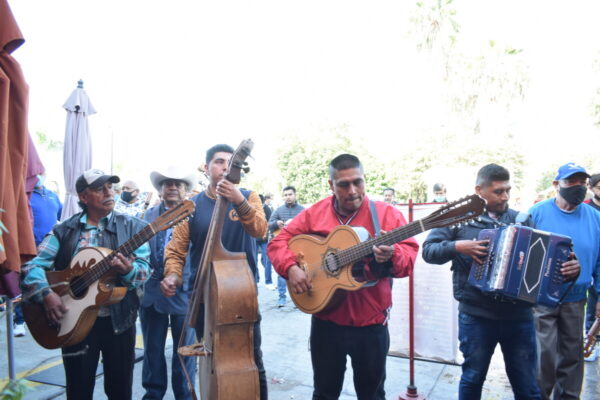
Las agrupaciones musicales que conviven en las zonas turísticas de Chapala no sólo son nativos del municipio, sino también de poblaciones circunvecinas.
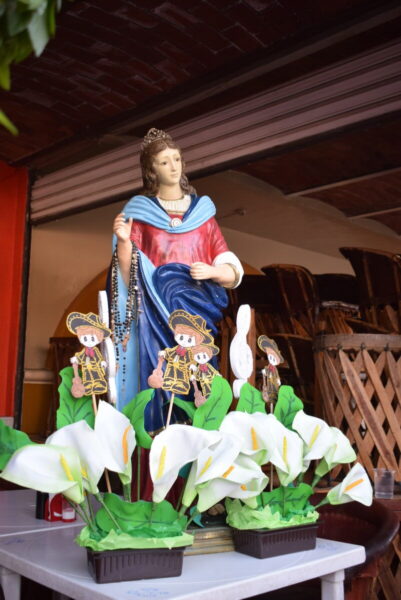
La imagen de Santa Cecilia recorrió cada restaurante antes de regresar a su capillita, ubicada en el extremo oriente del malecón de Chapala.
Gremio de la agricultura de Ajijic en peligro de desaparecer
Parroquia de San Andrés Apóstol, donde se encuentra el patrono de Ajijic. Las fiestas en honor a San Andrés Apóstol se realizan del 21 al 30 de noviembre.
Sofía Medeles (Ajijic, Jal.)- Sin campos para sembrar y sin vacas para arrear en Ajijic, el gremio de los agricultores, que en su tiempo fue uno de los más fuertes, hoy es uno de los más golpeados en las fiestas patronales de la delegación.
Semanario Laguna, conversó con una de las integrantes (por herencia) del gremio. Se trata de Ramona Díaz, que recibió al medio fuera de su casa, escondiendo sus manos para protegerse del frío, y quien con nostalgia comentó que su permanencia en el gremio se debe a que lo heredó de su papá, quien lo heredó de su abuelo, y afirmó que el gremio es uno de los que más se ha ido apagando con el tiempo.
“Antes era un día fuerte, porque había mucho de agricultura y ganadería, pero se han ido haciendo menos. Hoy en día somos menos de 25 los que cooperamos. Y es que ya no hay donde sembrar ni donde tener ganado, por eso se ha ido perdiendo”, mencionó mientras alzaba un poco la voz para poder sobresalir entre el ruido de camiones y coches que pasaban fuera de su hogar.
Prosiguió aseverando que ya solo les queda el nombre, porque de ese oficio quedan solo memorias, y que probablemente, se quede en esta última generación. “Yo no creo heredarlo a mis hijos, porque ya no están tan comprometidos con la fe ni con el oficio. No solo mis hijos, muchos jóvenes ya no se acercan a la religión hoy en día”.
Aseguró que, además, otro de los factores importantes en la falta de cooperación no solo a su gremio, sino a todos, es que los jóvenes ya no son muy cercanos a las tradiciones. “En San Juan Cosalá, el día de los jóvenes es un día vistoso con mucho festejo, pero aquí es diferente, porque han ido dejando de lado religión y costumbres, solo ven el festejo”.
Mirando hacia un costado, recuerda una tradición que está básicamente perdida, en la cual, el gremio del día siguiente realizaba una pequeña procesión con faroles para llegar a la última misa del día, que representaba que estaban recibiendo su día. A esto le llamaban “entrada”. “Sería bonito que las que participamos en los gremios, nos pusiéramos de acuerdo para usar un rebozo y llevar nuestros mechones, así mostramos más nuestras tradiciones y raíces”.
Finalmente, hizo un llamado a la comunidad de Ajijic, adultos, jóvenes y niños, a involucrarse más en las tradiciones que quedan, ya que, con orgullo, dice que es parte de lo que hace mágico a Ajijic. “Otra que recuerdo, es la batalla de las rosas –hombres que les daban rosas a mujeres durante los bailes en la plaza-, era bonito y divertido, se debería volver a hacer y motivarlos, por ejemplo, darle un premio a la que tenga más rosas. No dejemos morir las tradiciones que nos hicieron lo que somos”.
El dato
Las fiestas patronales son de origen europeo, llegaron a México a través de los españoles, los cuales, se manejaban por cofradías -organización reconocida por la iglesia católica con personas con los mismos intereses profesionales o altruistas-, los cuales, adaptándose a las costumbres mexicanas, se convirtieron en gremios.
Hoy en día, los gremios son grupos de personas con el mismo oficio que se reúnen para la celebración religiosa patronal del pueblo donde habitan, organizan los gastos del día y las actividades a realizar durante el festejo. Al ser novenarios por santo patrono, suelen ser nueve gremios.
Sí dieron permiso para que Ajijic celebre a su Santo Patrono
San Andrés Apóstol, santo patrono de Ajijic.
Sofía Medeles (Ajijic, Jal.)- A pocos días de que iniciaran las fiestas patronales de Ajijic (del 21 al 30 de noviembre), por fin las autoridades han dado luz verde para su realización, que debido a las restricciones de la pandemia, se vivirán como los antepasados acostumbraban. Es decir, a la antigua.
Y es que, la condición por parte de las autoridades para dar permiso para su realización fue que se respete un horario límite de hasta las 12:00 de la noche, un aforo restringido, filtros sanitarios a cargo de los gremios, señalética para delimitar entradas y salidas, uso permanente de cubrebocas y vigilancia por parte del Gobierno Municipal.
Por su parte, el encargado de despacho de la delegación, Maximiliano “Max” Macías, comentó que se está trabajando en conjunto con comerciantes, gremios y grupos organizadores, para poder traer un festejo muy sano y muy a la antigua.
“Serán diferentes esta vez las fiestas, como para venir en familia, pasar un rato y cenar. Vamos empezando poco a poco y reactivando la economía, por ejemplo, de comerciantes que no han podido tener sustento, se les va a permitir trabajar, siempre y cuando respeten lo requerido por la Secretaría de Salud”, aseveró Max.
Asimismo, a través de la página de la delegación -Delegación Ajijic 2021-2024-, se publicó el calendario de actividades del novenario, donde los días 22 (gremio de músicos), 23 (gremio de comerciantes), 24 (titulares de terrazas que llegaron a un acuerdo) y 25 (nuevo gremio de jóvenes), acordaron llevar agrupaciones musicales (que se tendrán que presentar en el kiosco), mientras que del 26 al 30 de noviembre, las actividades que se harán, serán dependiendo del presupuesto de los gremios restantes.
La gente ha tomado esta noticia como buena, ya que, tanto en redes sociales como en entrevistas realizadas por Semanario Laguna, expresaron su alegría por la realización de las fiestas. “Es bueno porque por una parte vemos como poco a poco vamos saliendo de esta pandemia, y por otro lado porque le dan un espacio para divertirse a la población”, resaltó Sara, una entrevistada de Ajijic.
Finalmente, el encargado de despacho llamó a los asistentes a las celebraciones en honor a San Andrés el apóstol, y a los comerciantes, a respetar las medidas establecidas, de lo contrario, con todo y pena, se les llamará la atención.
Ajijic’s agricultural guild in danger of disappearing
St. Andrew Catholic Church.
Sofía Medeles (Ajijic, Jal.)- With no fields to sow and no cows to herd in Ajijic, the farmers’ guild, once one of the strongest of the nine guilds, is now one of the hardest hit in the Ajijic’s patron saint festivities.
The festivities in honor of San Andrés Apóstol are held from November 22 to 30 In the Parish of San Andrés Apóstol, where the patron saint of Ajijic is located.
Semanario Laguna spoke with one of the members (of the guild. Ramona Díaz, received the media outside her house hiding her hands to protect herself from the cold, nostalgically commented that her membership in the guild is because she inherited it from her father, who inherited it from her grandfather. Senora Diaz acknowledged that the guild is one of those that has been fading the most with time.
«It used to be a robust day because there was a lot of farming and ranching, but the guild members have been doing less and less. Today there are fewer than 25 of us who cooperate, and there is no longer anywhere to plant or have livestock, that is why the festivities have been lost,» she mentioned while raising her voice a little to be able to stand out among the noise of trucks and cars passing by outside her home.
She went on to say that the only thing left is the name, because only memories of this trade remain, and they will probably be those of this last generation. «I don’t think I will pass it on to my children, because they are no longer committed to the faith or to the profession. Not only my children, many young people no longer approach religion today.»
She said that another important factor in the lack of participation not only in her guild, but in all the guilds,is the diminished the day of the youth which is a colorful day with a lot of celebration in other areas, but here it is different, because they have been leaving aside religion and customs, they only see the celebration.»
Looking to the side, she recalls a tradition that is basically lost, in which the guild on the following day, made a small procession with lanterns to get to the last mass of the day which represented that they were receiving their day. They called this the «entrada.» «It would be nice if those of us who participate in the guilds could agree to wear a shawl and wear our tresses, so we could show more of our traditions and roots.»
Finally, she called on the community of Ajijic, adults, youth and children, to get more involved in the traditions that remain since, with pride, she says it is part of what makes Ajijic magical. «Another one I remember, is the battle of the roses -men giving roses to women during the dances in the plaza. It was nice and fun. It should be done again and we could motivate them, for example, by giving a prize to the one with the most roses. Let’s not let the traditions that made us what we are die.»
Translated by Sydney Metrick.
Mariana Macías arrived in Thailand to represent México in beauty contest
Mariana Macías, originally from San Antonio Tlayacapan.
Laguna staff. Mariana Macias, originally from San Antonio Tlayacapan, set foot on Thai soil to begin her quest for Miss Grand International. On Sunday night the winner of the «Miss Grand Mexico 2021» beauty pageant landed at Phuket International Airport to represent Mexico in the ninth edition of Miss Grand International 2021, on December 4.
The Lourdes Chapel will open its doors to the public after three years of being closed
The neighbors of the Lourdes neighborhood will see the doors of their chapel open to the public for the celebration of the Virgin of Guadalupe. Photo Jazmín Stengel.
Jazmín Stengel – After being closed to the public for more than three years and after six months of restoration work, the Chapel of Lourdes will finally open its doors to the public to commemorate the day of the Virgin of Guadalupe on December 12, as was done in 1940.
To date, more than 500,000 pesos (almost $24,000 USD) have been invested in the restoration work, according to the civil engineer, Enrique Petersen. These resources come from what the neighbors have been able to raise through donations, most of the time in material.
«Unlike earlier, they now prefer anonymous donations», commented Alejandra Martinez, daughter of Tere and Jose (Pepe) Martinez, neighbors of the community and treasurers of this collection. She added that many Chapalenses and foreigners have contributed their share, including Enrique Petersen who undertook the job of directing the work without charging a peso.
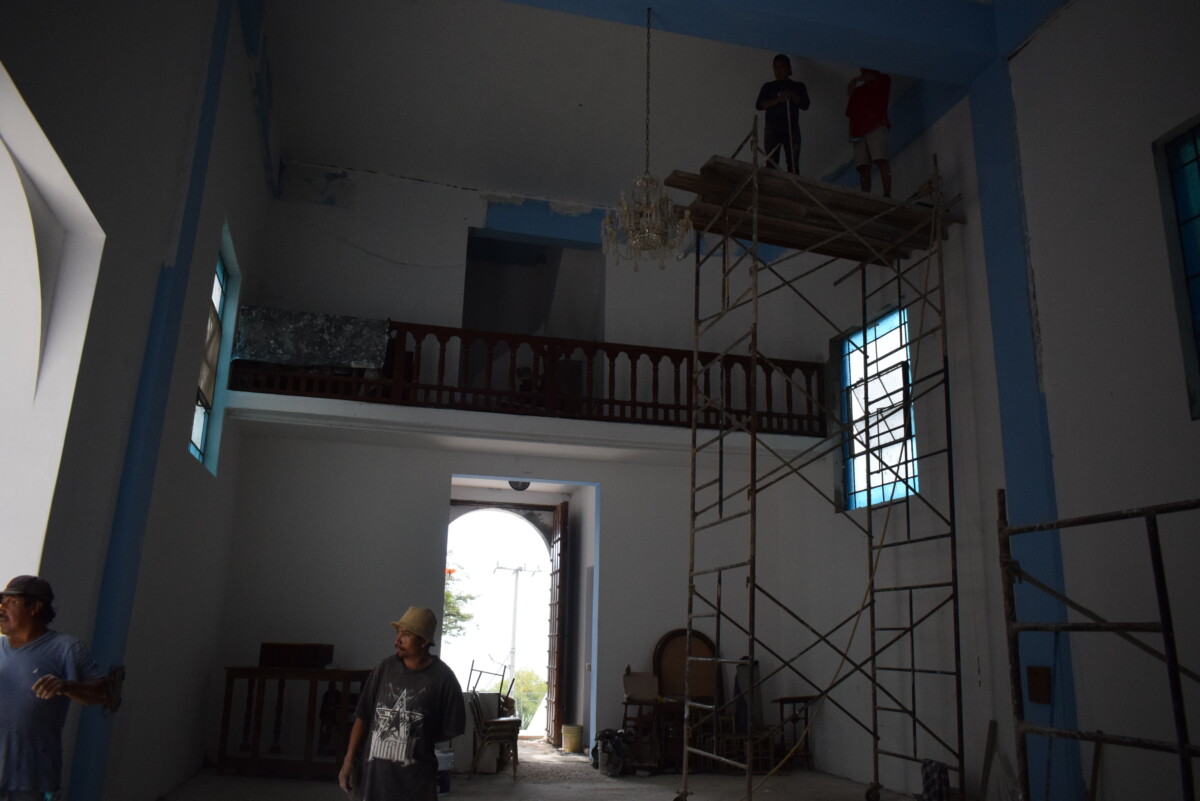
After six months of restoration work, there are still pending details of painting and finishing in the temple. Photo Jazmín Stengel.
The task has not been easy, since the labor expenses and some materials not donated tallied up to 70 thousand pesos one month, with even more expenses. The average monthly expenses remained at 20 thousand pesos, which has covered the payroll of four stonemasons.
The steady collection of resources has been maintained thanks to fairs, raffles, sales, and the monthly contributions of more than 200 pesos, which the neighbors of the neighborhood pledged to contribute.
Petersen said that when he began the plans for the restoration of the exterior, he discovered the poor condition of the foundation, and that part of the only tower was cracked.
«We started by fixing the base of the chapel and reinforcing its walls with metal and concrete, we removed the outside balcony that was pushing out one of the walls and repaired the cracks,» said the engineer, who added: «These details and water leaks from the hill impacted the infrastructure severely enough to close it in September 2019, almost 80 years after its inauguration,» he concluded.
At the end of the first stage of restoration, only cosmetic and finishing details such as painting, carpentry and gardening are pending, for which more budget is needed. However, the committee in charge, together with engineer Petersen, decided to reopen the chapel so that the community can see what has been achieved.
The chapel was built in 1940 by Guillermo González Hermosillo y Brizuela, who led the cooperation between the neighbors of Colonia Francesa and the Ixtle neighborhood to make possible the construction of the sanctuary.
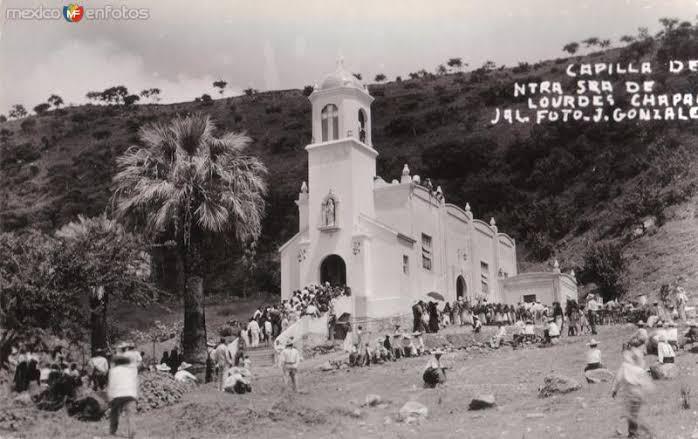
Photograph of the first years of the Lourdes Chapel. Photo: J. González.
Now it is the turn for the second generation of neighbors, the heirs of the luxurious country houses in Colonia Francesa and the inhabitants of the renowned neighborhood of Lourdes in Chapala, named in honor of their patron saint. These neighbors continue the restoration of the shrine week after week by selling churros, fritters, and sweets outside after mass, and others by making extravagant anonymous donations.
The fundraising work continues to help fund the remaining restoration work, and the next fair is already planned to be held on November 28 outside of the Parish of San Francisco de Asis. Another fair is planned for December 5 outside of the Chapel of Lourdes.
Translated by Kerry Watson.
The religious novena honoring St. Andrew the Apostle to be held in traditional manner
The banner listing the program of activities and participating guilds is on the façade of the church of St. Andrew the Apostle.
Sofía Medeles (Ajijic, Jal.)- The novena of nine days of religious celebrations to honor St. Andrew the Apostle will be carried out at the church in the customary way -unlike the celebrations in the main plaza, which will be modified- with the traditional mañanitas, masses, rosaries, and adoration of the Holy Eucharist.
The mañanitas will be held at 7:00 a.m.; while mass will be held at three different times, 8:00 a.m., 12:00 p.m. and 7:00 p.m. Rosaries will be at 6:30 p.m., and adoration of the Holy Eucharist- in the hands of adorers and honorary adorers – will be on Wednesday, November 24, Thursday, November 25 and Friday, November 26.
Translated by Kerry Watson.
New administration working hard to beautify Ajijic’s boardwalk
Officials painting the fencing along the boardwalk. Photo: Santiago Baeza
Sofía Medeles (Ajijic, Jal.)- Officials of the current PAN administration of Chapala, gave a facelift to the Ajijic boardwalk, painting area blue which previously were orange.
«We haven’t been able to address it as much as we would like, but we’ve already started. We are going to continue throughout the park and the boardwalk, renewing the paint of the dining areas and library, and at the beginning of the year we will start to renovate the aging grills» said Ajijic Delegado or town administrator Maximiliano «Max» Macias Arceo, who promised that the boardwalk and the beaches of Ajijic will continue to be beautified.
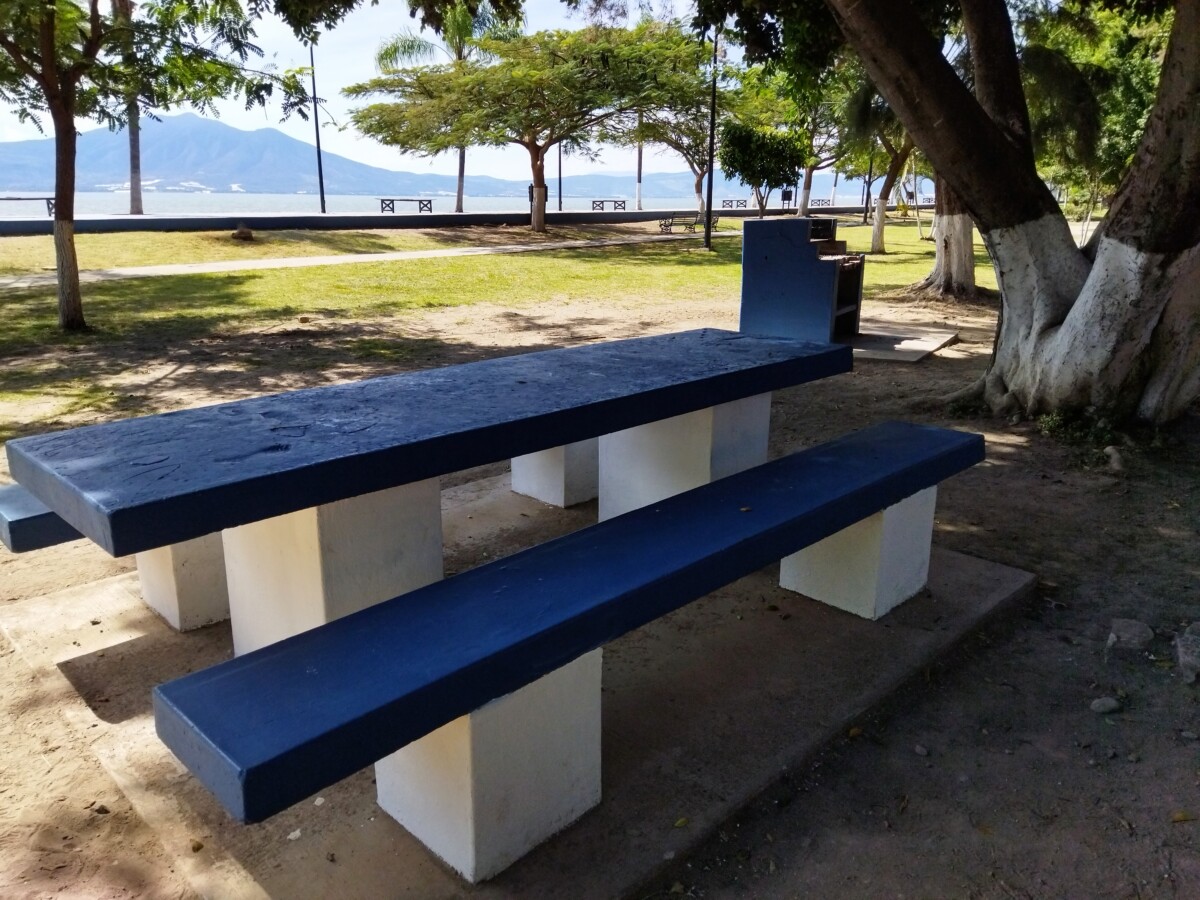
Painted and clean, this is how the dining areas and grills look. Photo: Sofía Medeles.
The Delegado said that a search has already begun for a new water pump to irrigate the green areas. He emphasized that the line will not be connected to the Municipal Potable Water and Sewage System (SIMAPA), but will take water from the lake, to improve the distribution of water to the neighbors of the boardwalk.
The green benches without back supports that were removed from the Ajijic plaza due to popular complaint will also be repaired and then relocated back to the boardwalk.
«We are looking to designate one day a week to clean up the boardwalk, remove the “lirio” or floating seaweed, and provide maintenance. We still don’t know if there will be new projects for these areas, but for the time being, they will be maintained and cleaned,» concluded the interviewee.
Translated by Kerry Watson
© 2016. Todos los derechos reservados. Semanario de la Ribera de Chapala


